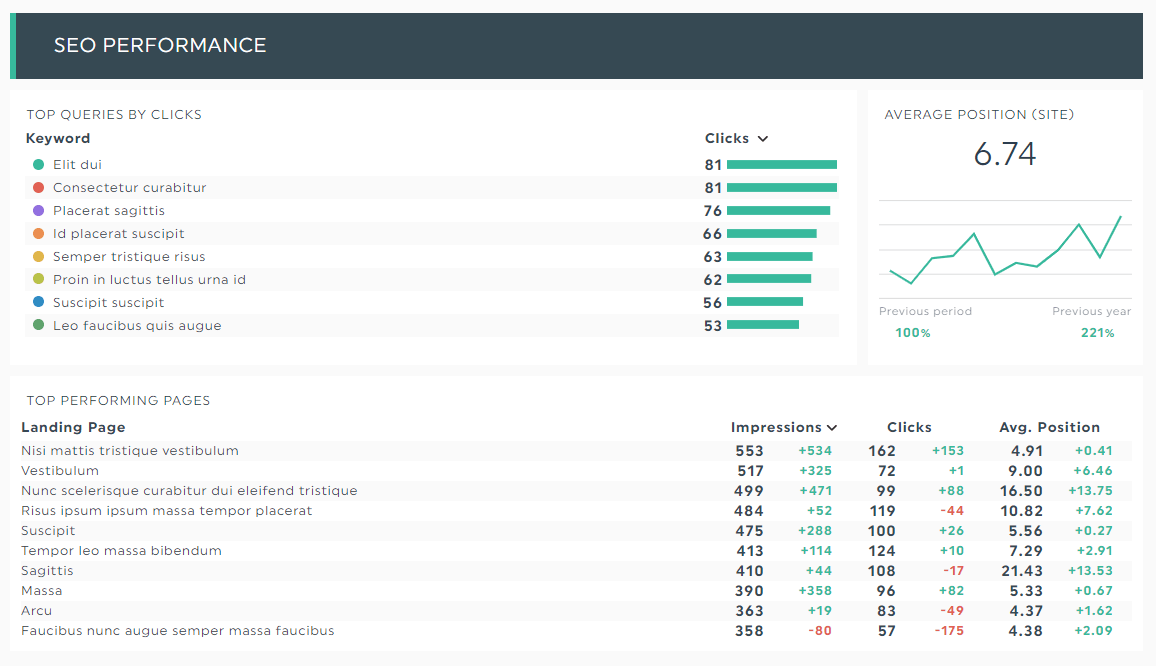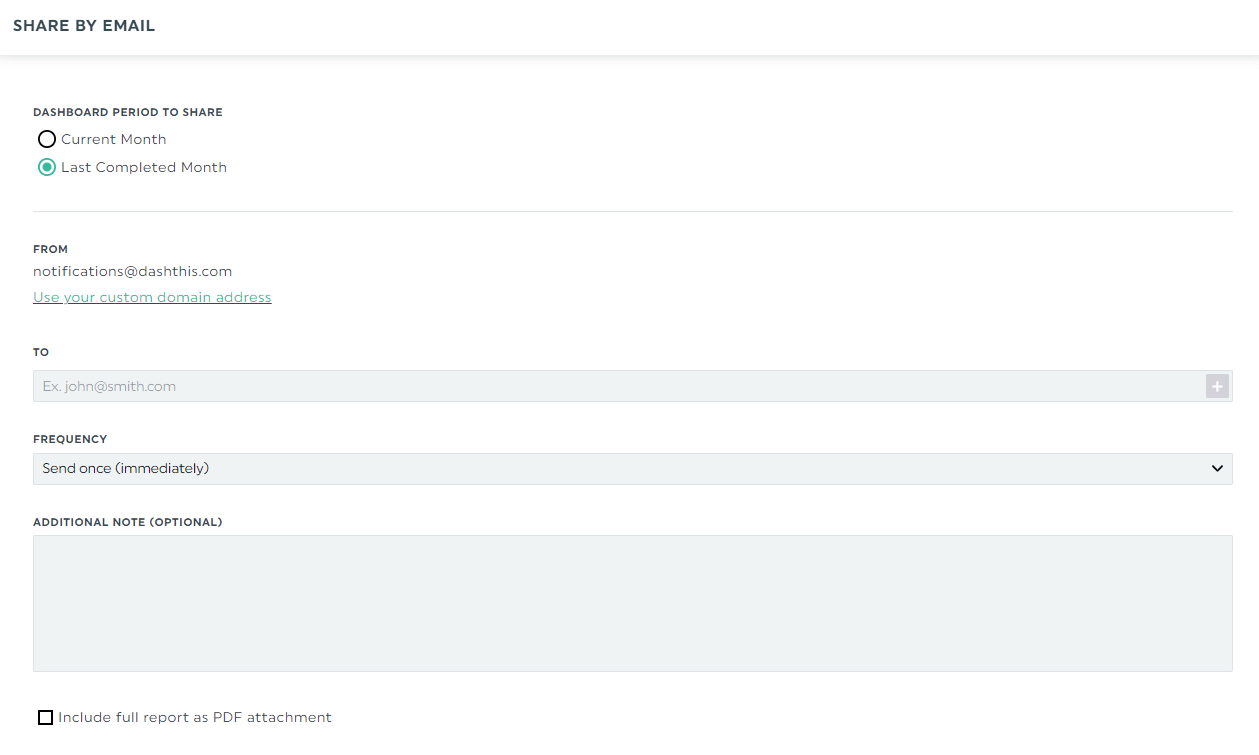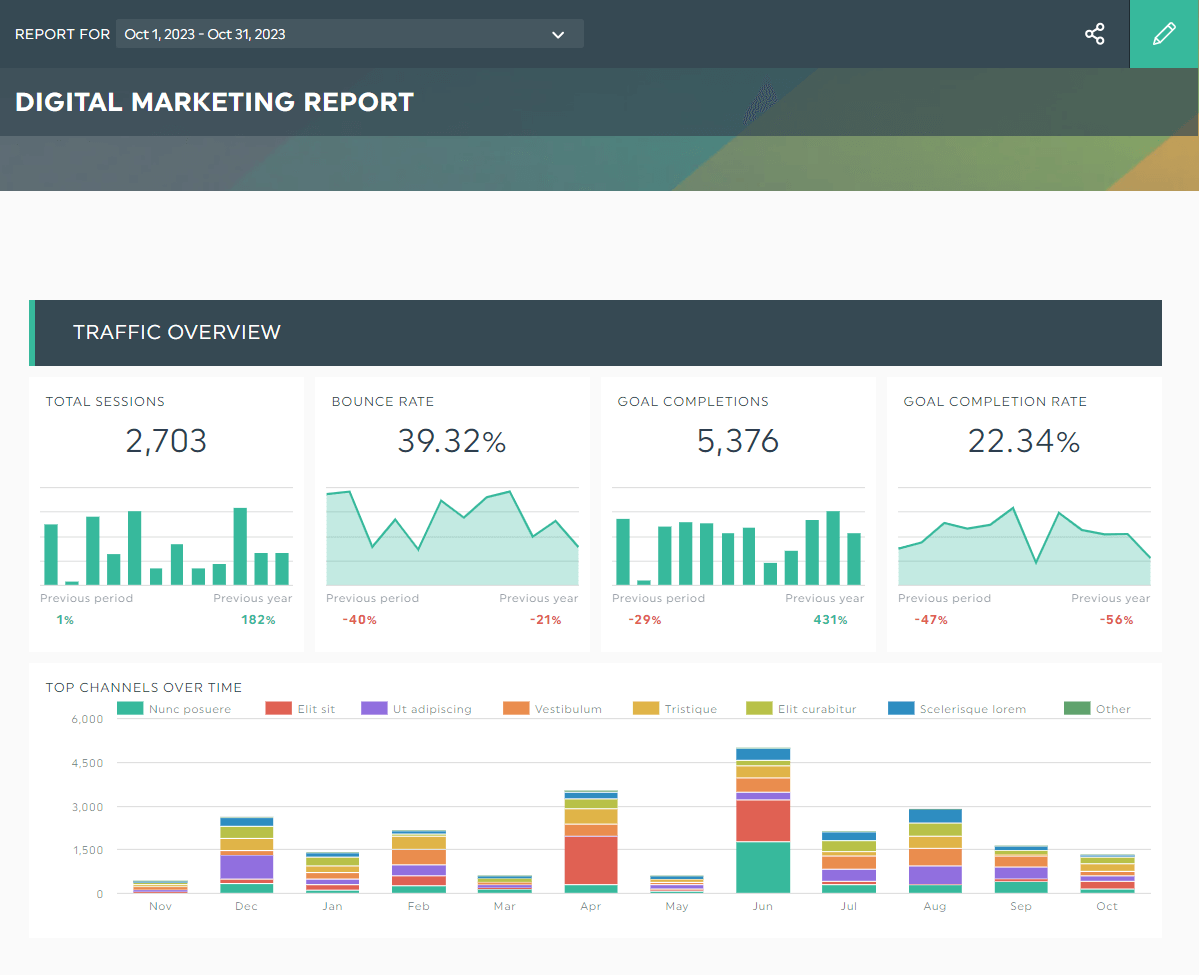Marketing Insights: The Ultimate Guide (Best Practices and How To)

Observations won’t move the needle forward.
But your marketing insights will.
These strategic realizations, usually born out of hours of analysis, help you gain a competitive edge and win in the market.
Today, we'll show you how to track your data automatically, so you can visualize all your data in one place, draw insights, and determine actionable recommendations for your next move.
Here's what we'll cover:
- Understanding Marketing Insights (Using Milk as an Example)
- Why Distilling Data Into Insights Is Crucial for Marketers
- Top KPIs and Metrics to Track Before Drawing Marketing Insights
- Streamline Data Analysis to Unearth Marketing Insights with DashThis
- Automate Your Marketing Insights Reporting Today!
Understanding Marketing Insights (Using Milk as an Example)
Marketing insights are strategic or tactical learnings distilled from large amounts of data. Often, they're used to inform marketing campaigns across the customer journey.
What’s the difference between data and insights?
Marketing data is raw figures tracked over a period. Whereas marketing insights are valuable, unrealized information extracted from data.
To describe them in simpler terms:
- Data: “What happened?”
- Analysis: “Why did it happen?”
- Insights: “What can we do about it?”
Let’s unpack how this looks with an example.
Imagine you run an oat milk ecommerce store. Now that the year is coming to a close, you want to spend the remaining funds in the EOY budget.
The goal? Increase store sales by the next quarter.
You decide to gather your entire ecommerce store sales data into a single report.

Data via DashThis, the easiest reporting tool that gathers your entire marketing data into one beautiful dashboard. Note how the data points show your performance across different periods. It makes data analysis a lot easier.
During data analysis, you dig into a bunch of quantitative data, including key sales, orders, and online store visitor activity; and qualitative data like user feedback.
You make an observation: High CLTV customers want more than oat milk.
Upon digging further, you discover an interesting consumer insight:
Your target audience is susceptible to brand switching. Instead of just oat milk, they’re buying different kinds of milk for unique occasions. For example, customers prefer cow’s milk in their morning cereal, high-protein milk in their post-workout shake, and almond milk in their decaf coffee.*
This insight leads you to partner with other milk brands and create multiple co-marketing campaigns over the next quarter.
Notice what happened here?
You now know which touchpoints in the customer experience to improve on. Rather than implementing a “spray and pray” marketing strategy that targets everyone, you’re honing in on your most profitable customer segment with a specific solution—all thanks to an insight extracted from a thorough analysis.
*This example is inspired by McKinsey’s latest report.
Why Distilling Data Into Insights Is Crucial for Marketers
Raw data is incoherent. But when analyzed and turned into actionable insights, it:
Drives decision-making
All strategic moves boil down to making informed decisions and executing them. To ensure you’re making the right decisions, let your data-backed customer insights take the lead.
Identifies emerging trends
The fastest company in any market will win. Companies that act on their insights and capitalize on market trends before they take off gain a competitive advantage.
Outperforms competitors
Drawing insights from market research and daily reporting unearths differentiators that set you apart from the competition.
Delivers accountability
It takes a considerable amount of effort to generate useful insights. Hold the team accountable by setting KPIs and metrics in your client marketing attribution reports (more below).
Top KPIs and Metrics to Track Before Drawing Marketing Insights
Here are the top metrics to measure your marketing funnel efficiency.
Social media engagement

Whether you use social media to understand customer needs, engage them, or reach loyalty and customer satisfaction, these popular metrics help you gauge the impact of your efforts.
Start measuring them to find your optimal posting time, identify the top-performing post, and track how each post across different channels contributes to web traffic, leads, and revenue.
Common KPIs:
- % reduction in cost per brand lift for ad recall
- % reduction in cost per acquisition from LinkedIn Ads
- % increase in app installs from Meta Advantage + app campaigns
Common metrics:
- Reach
- Impressions
- Click-through rate
- Engagement rate
- Cost per acquisition
Website traffic and user behavior

Your visitors’ interaction with your website tells you a lot of things, from the content that resonates the most to the products that capture their attention.
Measure these metrics to learn more about customer behavior towards online purchases (e.g., track if messaging is working).
Common KPIs:
- % of click-through rate from homepage to demo page
- Number of demos signed up
- % of increase in MQL:SQL conversion
Common metrics:
- Organic traffic
- Page views
- Pages per session
- Bounce rate
- Traffic sources
Email marketing performance

Email marketing may boast a high ROI, but that doesn't mean you should constantly poke into customers’ inboxes—especially when 49% of consumers say they receive too many emails from brands.
Take cues from the email metrics below. It'll indicate if customers want to hear from you…or not.
Common KPIs:
- Number of sales from welcome emails
- Number of conversions from sponsored emails
- % of click-through rate from winback email to product page
Common metrics:
- Deliverability rate
- Open rate
- Click-through rate
- Number of unsubscribes
- List growth rate
SEO & keyword analysis

SEO is a long-term strategy.
Companies that continue to invest in content during a downturn will steadily climb the SERPs and stay ahead of competition.
Track if you're making the most of your content budget with these SEO metrics.
Common KPIs:
- % increase in leads after content optimization
- Number of high-intent keywords in the top 5 search engine results
- $ of direct revenue from product-led post
Common metrics:
- Organic traffic
- Domain authority
- Number of backlinks
- Average keyword position
- Keyword rankings
Conversions

Your marketing strategy is pointless if it doesn't generate conversions—be it acquiring new leads or paying customers. These revenue-driven metrics show if your business offering is aligned with the target market.
Common KPIs:
- Number of monthly new leads
- Number of trial-to-paid users
- Number of won deals
Common metrics:
- Conversion rate
- Return on ad spend
- Number of leads generated
- Cost per acquisition
- Revenue attribution
Streamline Data Analysis to Unearth Marketing Insights with DashThis
DashThis is the easiest reporting tool.
It automatically grabs your entire marketing data across multiple online channels into one beautiful report.
Here's how you can get started:
- Select a premade report from 40+ templates
- Connect your favorite marketing tools with DashThis
- Choose metrics in Preset Widgets
Sit back, while DashThis automatically gathers your entire marketing analytics into the report. Drag and drop the metrics as you see fit.

Customize the report to fit your client’s branding.
Click Color Themes on the top right bar and take your pick from 12 preset themes. To unlock a custom theme, upgrade to a Professional Plan.
You can also add a comment box within the report to share your marketing insights. This saves you the trouble from starting a new email thread to explain your findings.
Click Static Widget > Comments to add your insights in bullet points.

Click Save.
Once you’re done, share the report with clients.
Hover to the Sharing Options icon on the top right and click Share by Email. Set the dashboard period and frequency, along with the client’s email address.

From here, clients can view your insights and their marketing performance in the same place in real-time.
Digital marketing report template
Combine all inbound and outbound marketing channels into one place. This report measures if your entire digital marketing efforts drive acquisitions and conversions.

Grab this digital marketing insights template with your own data!
Automate Your Marketing Insights Reporting Today!
Observations alone won't move the needle forward.
To drive strategic change across the company, you need to actively track data, draw insights on your best customers today, and lay out the next steps.
The challenge now lies in integrating all your marketing channels into one place.
Gather your entire marketing data into one beautiful report with DashThis. By having all data at a single glance, you can quickly analyze your overall marketing performance and draw unique insights to give your company a competitive edge.
DashThis is the easiest reporting tool. Pricing starts at $38 per month when billed annually. Start your free 15-day trial to make sense of your data today.
Ready to track your marketing insights?
Read More
Don’t miss out!
Automate your reports!
Bring all your marketing data into one automated report.
Try dashthis for free

